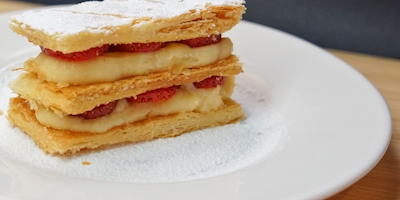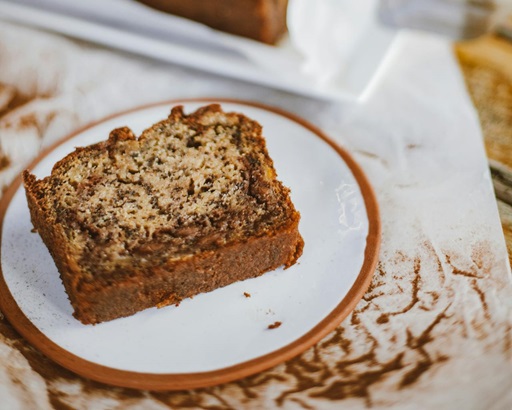What is Mille-Feuille?
Mille-feuille, whose name literally translates as “thousand leaves”, is an emblematic dessert of French origin that is strongly present in the country’s pastries. This delicious delicacy is mainly composed of layers of puff pastry, which are interspersed with generous portions of pastry cream, creating a combination of crunchy and creamy textures that captivate the palates. The top surface of mille-feuille is commonly decorated with a glossy glaze or a simple dusting of sugar, which not only enhances its appearance but also provides a sweet contrast to its flaky base.
The popularity of mille-feuille can be attributed to its great versatility. Although it is traditionally made with pastry cream, many pastry chefs have begun to experiment with variations that include different flavors, such as fruits, chocolate, or creams with infused flavors, resulting in endless combinations that maintain the essence of the original, but provide a modern touch. In addition, mille-feuille is a symbol of French haute pastries, serving as a reference in many pastry shops nationally and internationally.
This dessert is not only widely recognized in France, but has also gained recognition around the world, becoming a favorite at food festivals and cooking competitions. The skill required to prepare mille-feuille elevates it to a category of art, as proper handling of the puff pastry is crucial to achieving its distinctive texture and flavor. In short, mille-feuille is a timeless classic that reflects the rich culinary tradition of France and continues to fascinate dessert lovers in all corners of the planet.
*Some prices may have changed since the last review.
Origin of the Mille-Feuille and Meaning of its Name
Mille-feuille, an iconic dessert that has captivated many, has its roots in French gastronomy. Its name, which translates as “a thousand leaves”, refers to the complex layered structure that characterizes it. It is mainly composed of puff pastry alternating with cream, which gives it a crunchy and soft texture at the same time. Despite its simplicity in ingredients, the mastery of preparation is what really defines this dessert.
There are various theories about the origin of mille-feuille. Some experts believe that it dates back to the 16th century, in the court of the Kings of France, where new baking techniques were experimented with. It is said that chefs of the time began mixing layers of puff pastry with creams and jams, resulting in what we know today as mille-feuille. Another theory suggests that the dessert was inspired by an Italian classic that, when merged with French culture, gave rise to this pastry masterpiece.
Over time, mille-feuille has evolved and adapted to different palates, making various versions part of the contemporary pastry repertoire. Nowadays, it is not uncommon to find variants that include innovative flavors such as chocolate or coffee, further broadening the appeal of this delicious dessert. However, classic mille-feuille, with its balanced proportion of puff pastry and cream, remains a favorite in bakeries and restaurants around the world. Its name, which evokes the image of a thousand layers, captures the essence of its delicacy and complexity, inviting gourmets to enjoy every bite.
Step by Step Recipe to Make Mille-Feuille at Home
Below is a detailed recipe to prepare delicious mille-feuille at home. This French dessert, which is also known as “thousand-leaf cake,” consists of layers of puff pastry and pastry cream. To start, we will need the following ingredients.
Ingredients:
- 500 g puff pastry
- 500 ml whole milk
- 100g sugar
- 4 egg yolks
- 50 g of cornstarch
- 1 teaspoon vanilla essence
- Powdered sugar to decorate
Now, let’s move on to the instructions for preparing our mille-feuille. First, we preheat the oven to 200°C. We roll out the puff pastry on a lightly floured surface, making sure it is a uniform thickness. Then, we cut the dough into rectangles of the desired size, which will be the bases of our dessert.
We place the rectangles on a baking sheet and apply a little pressure with a fork to prevent them from puffing up while baking. Bake for approximately 15-20 minutes, or until golden and crispy. Once cooked, we let them cool on a rack.
While the dough is cooling, we can prepare the pastry cream. In a saucepan, heat the milk over medium heat. In a bowl, beat the egg yolks with the sugar and cornstarch until you obtain a smooth mixture. When the milk is hot, slowly pour it over the yolk mixture, stirring constantly to prevent them from coagulating. We return the mixture to the heat and cook it, stirring constantly, until it thickens. We add the vanilla essence and let it cool.
Once the cream and dough are cold, we proceed to assemble the mille-feuille. We alternate layers of dough and cream, starting and ending with the dough. Sprinkle with powdered sugar to give it an elegant touch. With these steps, you can enjoy an exquisite mille-feuille made at home, respecting the traditions of French pastry.
Tips for Preserving and Storing Mille-Feuille
Mille-feuille, characterized by its crisp layers of puff pastry richly softened with cream, is a dessert that is best when eaten fresh. However, there are effective methods to preserve and store this delicacy, ensuring that it maintains its freshness and flavor over time. The most important thing is that the mille-feuille is stored properly to prevent the puff pastry from becoming soggy and losing its crunchy texture.
Once you prepare your mille-feuille, it is advisable to keep it in the refrigerator if you plan to consume it in the next few days. To do this, cover the dessert with plastic wrap or place it in an airtight container, making sure it is not in direct contact with items in the refrigerator that can transfer moisture. This step is crucial to preserve the quality of the dough and cream sheets, minimizing the possibility of softening.
If you have leftover mille-feuille, it is best to consume it within three to five days. However, if you want to preserve it for a longer period, consider freezing portions. Be sure to wrap the mille-feuille individually in plastic wrap and then place it in a freezer-safe container. This will prevent ice crystals from forming which could affect the texture.
When reheating frozen mille-feuille, removing it from the freezer and letting it thaw in the refrigerator for several hours is the best approach. Once thawed, if you want to give it back some of its original crunch, you can heat it briefly in a preheated oven on a low temperature. Some may enjoy variations such as chocolate or fruit mille-feuille that provide a different twist, while maintaining the essence of the original.
“Some links on this page are affiliate links. And they could bring a financial benefit to Heavenlyflavor.site at no additional cost to you.”





:background_color(white)/hotmart/product_pictures/85ecd62a-2e40-49da-b367-27e2a0805038/cakedecorator.png?w=920)



